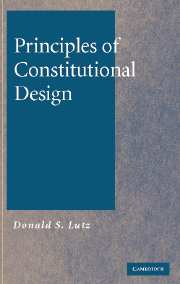Book contents
- Frontmatter
- Contents
- Preface
- Acknowledgments
- Principles of Constitutional Design
- 1 Constitutionalism: An Initial Overview and Introduction
- 2 Sovereignty
- 3 Popular Sovereignty
- 4 The Separation of Powers
- 5 Analyzing the Interaction between Popular Control and the Separation of Powers in the Amendment Process
- 6 Matching a Government to a People
- 7 An Overview of the Constitutional Design Project
- 8 An Underlying Constitutional Logic: Rational Actors?
- Index
8 - An Underlying Constitutional Logic: Rational Actors?
Published online by Cambridge University Press: 29 July 2009
- Frontmatter
- Contents
- Preface
- Acknowledgments
- Principles of Constitutional Design
- 1 Constitutionalism: An Initial Overview and Introduction
- 2 Sovereignty
- 3 Popular Sovereignty
- 4 The Separation of Powers
- 5 Analyzing the Interaction between Popular Control and the Separation of Powers in the Amendment Process
- 6 Matching a Government to a People
- 7 An Overview of the Constitutional Design Project
- 8 An Underlying Constitutional Logic: Rational Actors?
- Index
Summary
Four Interesting Curves
Our aim in this book has been to consider principles of constitutional design in order to better understand the project as a whole rather than to develop formulae for designing constitutions. The nature of the project demands such a stance, because, if a constitution must be matched to the people who will live under it, there is no one ideal or model constitution. Instead, the history of constitutionalism shows that there is a large variety of possible successful designs. Still, various empirical regularities have emerged that can be used by framers of constitutions as they consider the preferred institutional pattern that best suits them; as a result, although there is not an overall science of constitutional design, the design project can be informed by political science.
Several empirical findings fairly plead for further explication, because together they suggest a deeply interesting aspect of constitutional design. Under conditions of liberty, those who frame constitutions exhibit a set of patterned choices that suggest constitutionalism has a certain underlying logic, and perhaps an underlying rationality. We will examine these four curves that designers seem to strain toward without conscious intent: the index of amendment difficulty generating a nearly hyperbolic curve with respect to amendment rate; the size of legislatures tracking the curve for the cube root of the population; the separation of powers increasing as popular control increases; and the historical curve for constitutional democracies tracking the curve for the number of written constitutions.
- Type
- Chapter
- Information
- Principles of Constitutional Design , pp. 221 - 250Publisher: Cambridge University PressPrint publication year: 2006



